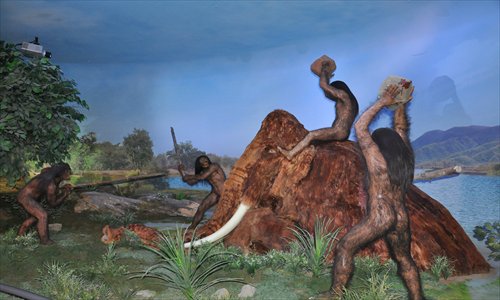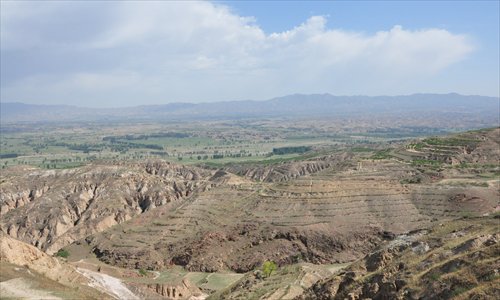Origins of man?
By Xu Ming Source:Global Times Published: 2012-6-10 19:50:02
sculptures at Nihewan Museum


sculptures at Nihewan Museum


scene of Nihewan Basin
The Nihewan Museum, in Yangyuan county, Hebei Province, opened Saturday in time for China's 7th World Heritage Day. This is the first domestic museum to exhibit relics spanning from the Old Stone Age to the New Stone Age.
Starting construction in 2007, the museum draws on the resources of Nihewan Lake and displays drawings, sculptures and interactive technology.
Museum exhibitions show scenes of human beings dating back 2 million to 5,000 years. Over 50,000 relics unearthed from Nihewan sites are shown, including stone tools, fossils, skulls and teeth. There are interactive elements as well; visitors can practice building fires, making stone tools and more, using electronic touch screens.
"It is difficult to exhibit relics from the Paleolithic period in an [interesting] way. Nihewan Museum displays the relics accurately and interactively," said Shi Jinming, the director of Shanxi Museum and an archaeologist.
Nihewan Basin
A half hour drive from the museum is Nihewan Basin, where much of the museum collection was gathered. Two million years ago, Nihewan Basin, located along the Sanggan River in Yangyuan, was once a large lake of over 9,000 square kilometers.
The basin is internationally known for holding stone tools and ancient animals and plants fossils from the earth's Quaternary Period.
To this date, 156 relic sites, including Majuangou, Xiaochangliang, and Donggutuo, have been discovered at the Nihewan Basin, with over 100,000 relics unearthed.
Currently, there are 53 sites from primitive tribes across the world and 46 are in China.
Among them, 40 are in Nihewan's relic group. The high density of sites makes Nihewana an invaluable archeological and academic site.
An excavated scraper found in an elephant's rib on the Majuangou site pushed the estimated origin of Asia's civilization back about 2 million years.
This makes Nihewan the only relic site comparable to the Olduvai Gorge in eastern Africa, known as "the cradle of mankind." It challenges the theory that Africa is the sole origin of mankind.
Wei Qi, an archeologist at Chinese Academy of Sciences, dedicated to the excavation of Nihewan site for 41 years and a discoverer of Houjiayao site said that primitive humans living in Nihewan goes as far back as 1.77-1.95 million years.
"If we can discover a single stone tool 2.5 million years ago in Nihewan, it proves the existence of human beings at that time. Then Nihewan, instead of Africa, will be the origin of humankind. It is a matter of when, who and in which stratum the fossils of ape man will be found in Nihewan," he said.
The research and excavation of Nihewan site can be traced back to the early 20th century when several foreign missionaries and archeologists began collecting geological data and collected fossils in the area.
Chinese archeologists participated in the research of Nihewan's topography in the 1940s and research expanded with the government's support. The value of this basin is recognized by the archeological circle.
In 1998, Yujiagou site was named one of the 10 biggest discoveries in archeology in China. In 2000, the investigation of Nihewan's old stone tools was honored as one of the 100 significant archeological discoveries in the 20th century.
In 2002, the site was approved by the State Council as a national natural reserve. It plans to apply to be a world cultural heritage.
Tourism in Yangyuan
A poverty-stricken county, Yangyuan county government is working on developing itself as a resort and scenic spot for cultural relics.
Local officials said they hope the museum, which costs roughly 50 million yuan ($7.85 million), along with the Nihewan site will boost the tourism industry and local economy.
"The museum is the first step in developing tourism. A series of tourism projects, including Xiaochangliang scenic spot and the cultural relics park will open to the public in the upcoming years," Zhao Aimin, deputy magistrate of Yangyuan country, told the Global Times.
Zhao said the tourism industry in Yangyuan is very promising. He places importance on making the subject interesting and approachable. "If people don't understand it, you can't expect them to tour here," he said.
Xie Fei, deputy director of Hebei's heritage bureau, said in addition to spreading word about the museum, it's also about enhancing the local culture, society and economy development.
He said that they are considering inviting the public to join the process of archeological investigation to make it interactive.
A total of 6.64 billion yuan will be invested in building Yangyuan as a tourist site. Official statistics show that the area attracted 50,000 visitors during the three-day vacation on Labor Day. Zhao said the number of visitors is expected to increase greatly after the museum opens. A four-star hotel is set to open next year in the county.
"The discovery would attract more visitors. However, tourist facilities and service quality should be improved first," said Wang Qiyan, professor of leisure economy at Renmin University of China, adding that at the moment, basic things like infrastructure for tourists is lagging.
"Protecting the cultural relics is top priority. Without it, there can't be a healthy development of tourism," Li Mingde, a researcher in tourism at Chinese Academy of Social Sciences, told the Global Times.
Wei said that while relics are generally under good protection in China, it is important not to be complacent.
"We should protect relics preventively. We can't protect them from nature, so sometimes we need to intervene."
The Nihewan Museum, in Yangyuan county, Hebei Province, opened Saturday in time for China's 7th World Heritage Day. This is the first domestic museum to exhibit relics spanning from the Old Stone Age to the New Stone Age.
Starting construction in 2007, the museum draws on the resources of Nihewan Lake and displays drawings, sculptures and interactive technology.
Museum exhibitions show scenes of human beings dating back 2 million to 5,000 years. Over 50,000 relics unearthed from Nihewan sites are shown, including stone tools, fossils, skulls and teeth. There are interactive elements as well; visitors can practice building fires, making stone tools and more, using electronic touch screens.
"It is difficult to exhibit relics from the Paleolithic period in an [interesting] way. Nihewan Museum displays the relics accurately and interactively," said Shi Jinming, the director of Shanxi Museum and an archaeologist.
Nihewan Basin
A half hour drive from the museum is Nihewan Basin, where much of the museum collection was gathered. Two million years ago, Nihewan Basin, located along the Sanggan River in Yangyuan, was once a large lake of over 9,000 square kilometers.
The basin is internationally known for holding stone tools and ancient animals and plants fossils from the earth's Quaternary Period.
To this date, 156 relic sites, including Majuangou, Xiaochangliang, and Donggutuo, have been discovered at the Nihewan Basin, with over 100,000 relics unearthed.
Currently, there are 53 sites from primitive tribes across the world and 46 are in China.
Among them, 40 are in Nihewan's relic group. The high density of sites makes Nihewana an invaluable archeological and academic site.
An excavated scraper found in an elephant's rib on the Majuangou site pushed the estimated origin of Asia's civilization back about 2 million years.
This makes Nihewan the only relic site comparable to the Olduvai Gorge in eastern Africa, known as "the cradle of mankind." It challenges the theory that Africa is the sole origin of mankind.
Wei Qi, an archeologist at Chinese Academy of Sciences, dedicated to the excavation of Nihewan site for 41 years and a discoverer of Houjiayao site said that primitive humans living in Nihewan goes as far back as 1.77-1.95 million years.
"If we can discover a single stone tool 2.5 million years ago in Nihewan, it proves the existence of human beings at that time. Then Nihewan, instead of Africa, will be the origin of humankind. It is a matter of when, who and in which stratum the fossils of ape man will be found in Nihewan," he said.
The research and excavation of Nihewan site can be traced back to the early 20th century when several foreign missionaries and archeologists began collecting geological data and collected fossils in the area.
Chinese archeologists participated in the research of Nihewan's topography in the 1940s and research expanded with the government's support. The value of this basin is recognized by the archeological circle.
In 1998, Yujiagou site was named one of the 10 biggest discoveries in archeology in China. In 2000, the investigation of Nihewan's old stone tools was honored as one of the 100 significant archeological discoveries in the 20th century.
In 2002, the site was approved by the State Council as a national natural reserve. It plans to apply to be a world cultural heritage.
Tourism in Yangyuan
A poverty-stricken county, Yangyuan county government is working on developing itself as a resort and scenic spot for cultural relics.
Local officials said they hope the museum, which costs roughly 50 million yuan ($7.85 million), along with the Nihewan site will boost the tourism industry and local economy.
"The museum is the first step in developing tourism. A series of tourism projects, including Xiaochangliang scenic spot and the cultural relics park will open to the public in the upcoming years," Zhao Aimin, deputy magistrate of Yangyuan country, told the Global Times.
Zhao said the tourism industry in Yangyuan is very promising. He places importance on making the subject interesting and approachable. "If people don't understand it, you can't expect them to tour here," he said.
Xie Fei, deputy director of Hebei's heritage bureau, said in addition to spreading word about the museum, it's also about enhancing the local culture, society and economy development.
He said that they are considering inviting the public to join the process of archeological investigation to make it interactive.
A total of 6.64 billion yuan will be invested in building Yangyuan as a tourist site. Official statistics show that the area attracted 50,000 visitors during the three-day vacation on Labor Day. Zhao said the number of visitors is expected to increase greatly after the museum opens. A four-star hotel is set to open next year in the county.
"The discovery would attract more visitors. However, tourist facilities and service quality should be improved first," said Wang Qiyan, professor of leisure economy at Renmin University of China, adding that at the moment, basic things like infrastructure for tourists is lagging.
"Protecting the cultural relics is top priority. Without it, there can't be a healthy development of tourism," Li Mingde, a researcher in tourism at Chinese Academy of Social Sciences, told the Global Times.
Wei said that while relics are generally under good protection in China, it is important not to be complacent.
"We should protect relics preventively. We can't protect them from nature, so sometimes we need to intervene."
Posted in: ARTS